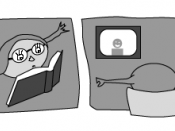When one can see the color red, there is no doubt as to what is being viewed. The question to ask is what is that ability attributed to? This is the concept that surrounds the heated debate over physicalism and non-physicalism. Both Frank Jackson and David Lewis claim to have knowledge on the issue, albeit opposing knowledge. Frank Jackson stands on the non-physicalist side, while David Lewis stands on the physicalist side. While there is much to be said on the topic, I will solely discuss and evaluate both positions.
Though his view has since changed, for the sake of this paper we will focus on Frank Jackson's argument that life is based on more than mere physical fact. He claims life is also experienced through learning. He bases this argument on an example he sets up. This example is a hypothetical situation where a girl named Mary is enclosed in a black and white room all her life.
In this room she learns all there is to know about the physical world, which includes all of chemistry, physics, and neurophysiology. When Mary finally leaves the room, she encounters the color red. According to Jackson, all her knowledge of red wouldn't prepare her for the actual experience of seeing red. Upon seeing the color, she would finally know what red really is. He makes this point by replying to three objections presented to his argument.
The first is reply is the three clarifications. In the first He explains that his statement is not that Mary couldn't imagine red. According to him, imagination is for those without knowledge. He states that Mary simply would not know what red is like without first hand contact. His second clarification is on the argument that she can't know. Jackson says that Mary couldn't...


